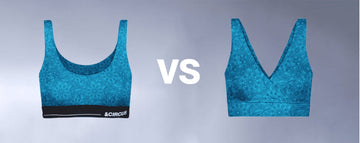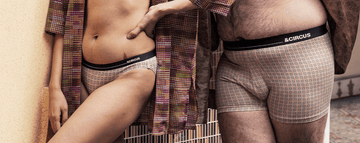Quick Listen:
Picture a bustling morning in Manhattan, where a jogger weaves through the crowd in a sleek windbreaker and leggings, her outfit a seamless blend of gym-ready and city-chic. This is the athleisure revolution, a style that's redefined casual fashion. But beneath the surface lies a quieter, more profound change: the rise of low-impact innerwear. It's not just about feeling good it's about doing good. Brands like Tailor and Circus are championing eco-friendly underwear crafted from organic cotton and biodegradable fibers, betting that this isn't a fleeting trend but a lasting pivot in how we choose what's closest to our skin. Is this a momentary fad or a seismic shift in consumer values? Let's dive in.
The Emergence of Low-Impact Innerwear
Low-impact innerwear isn't just a catchy phrase it's a commitment to sustainability and ethical production. Think bras woven from organic cotton, briefs spun from bamboo, and manufacturing that minimizes water waste and carbon emissions. The global lingerie market, valued at $104.4 billion in 2024, is forecast to reach $156.5 billion by 2033, growing at a 4.6% compound annual growth rate (CAGR). Within this, the sustainable underwear market is already worth billions and projected to double in size within five to seven years. The driver? Consumers are increasingly prioritizing clothing that reflects their environmental and ethical values, balancing comfort with planetary care.
At the forefront is Tailor and Circus, an Indian brand rooted in inclusivity and sustainability. Their innerwear, made from eco-friendly materials like organic cotton and Tencel, emphasizes hygiene and softness while reducing environmental harm. Unlike fast-fashion giants pumping out synthetic garments, Tailor and Circus champions ethical sourcing and low-impact production. This approach resonates with a growing demographic of shoppers who view their purchases as a vote for a more sustainable future.
Forces Fueling the Change
The data paints a vivid picture. The women's seamless underwear market, valued at $12.5 billion in 2024, is expected to climb to $20.9 billion by 2033, with a 6.2% CAGR, fueled by demand for comfort and style. The no-size underwear market, designed for inclusivity, is projected to reach $1.22 billion in 2025, growing at an 8.6% CAGR through 2033. These figures reflect a cultural shift toward body positivity, sustainability, and accessibility in fashion.
Sustainable materials are central to this transformation. Organic cotton, prized for its softness and hygiene, is a cornerstone for brands like Tailor and Circus. Bamboo and Tencel, which demand less water and energy, are also gaining ground. Innovations like biodegradable fabrics and moisture-wicking fibers are elevating sustainable innerwear from ethical to essential. Meanwhile, production advancements such as closed-loop systems that recycle water and cut waste are reshaping the industry's environmental footprint.
Consumers are the true engine of this shift. Social media, driving 40% of online lingerie sales, amplifies awareness, with 70% of women influenced by digital content. Younger shoppers, in particular, are dissecting brand's supply chains, demanding transparency and sustainability. The online lingerie market, valued at $89 billion in 2025, is projected to soar to $252 billion by 2033, propelled by e-commerce and eco-conscious demand. Brands are scrambling to meet these expectations, and the stakes couldn't be higher.
Real-World Impact: Tailor and Circus and Industry Peers
Tailor and Circus isn't just adapting to this trend they're shaping it. Their inclusive innerwear, crafted with low-impact materials and ethical labor practices, caters to diverse body types while prioritizing sustainability. They've tapped into a market craving products that feel good in every sense. But they're not alone. Patagonia, a pioneer in eco-conscious apparel, has expanded into sustainable base layers, while Tommy Hilfiger experiments with organic cotton underwear. Even Victoria's Secret, once defined by its glamorous runway shows, is evolving. At September's New York Fashion Week, they unveiled an adaptive intimates line designed for women with disabilities, merging style with accessibility.
Consumer enthusiasm is palpable. Surveys reveal that 65% of lingerie buyers prioritize comfort, while 35% seek sustainable options. Online reviews of Tailor and Circus highlight their softness and eco-credentials, and sales data backs this up: the global underwear market, valued at $99.23 billion in 2025, is expected to reach $147 billion by 2033, with sustainability as a key growth driver. This signals a clear demand for innerwear that aligns with both personal and planetary values.
Hurdles on the Path to Green
The road to sustainability isn't without obstacles. Eco-friendly materials like organic cotton and Tencel often carry higher costs, leading to pricier products. A $30 pair of sustainable briefs can feel extravagant when fast-fashion alternatives cost half as much, challenging brands to balance ethics with affordability. Supply chain constraints add another layer of complexity. Sourcing sustainable fabrics at scale is difficult, particularly as global demand outstrips supply. Smaller players like Tailor and Circus often face delays or limited material options, requiring creative solutions or tough trade-offs.
Consumer adoption remains a hurdle too. While 70% of women prefer seamless bras, not all are ready to embrace sustainability, especially in regions where price and convenience still dominate. The central question looms: is low-impact innerwear a passing trend or a fundamental shift? Skeptics argue it's a niche for affluent, urban consumers, unlikely to scale globally. Yet, with the sustainable underwear market set to double, analysts are optimistic, seeing it as a harbinger of broader industry change.
Opportunities for Forward-Thinking Brands
For brands willing to commit, the rewards are significant. Sustainability offers a powerful way to stand out in a saturated market. Tailor and Circus has built a loyal following by prioritizing eco-values and inclusivity, with a transparent supply chain that details everything from cotton origins to factory conditions. Circular fashion recycling old garments into new ones presents another opportunity, reducing waste and potentially lowering long-term costs.
The real jackpot is consumer loyalty. Shoppers who choose sustainable innerwear tend to stay with brands that reflect their values. With 60% of lingerie purchases made via mobile, brands that master e-commerce and storytelling think Instagram campaigns showcasing sustainable processes can capture this engaged audience. The online lingerie market's 13.9% CAGR underscores the potential for brands that align with this digital, eco-conscious wave.
The Road Ahead
Industry experts are optimistic about low-impact innerwear's future. Analysts predict it could become the standard within a decade, driven by younger consumers and stricter environmental regulations. Brands must act swiftly, investing in sustainable textiles, optimizing supply chains, and educating consumers. Tailor and Circus, for instance, uses blogs and social media to make eco-fabrics relatable, positioning sustainability as inclusive rather than exclusive.
The outlook is promising but not assured. If costs decrease and awareness grows, low-impact innerwear could redefine fashion's norms. If not, it may remain a premium niche. Still, the momentum is undeniable. As the underwear market races toward $147 billion by 2033, sustainability will be a defining battleground.
A Call to Lead
This isn't just about underwear it's about the planet's future. Brands like Tailor and Circus are proving what's possible, but the responsibility doesn't end with them. Other companies must embrace eco-materials and transparent practices to drive systemic change. Consumers hold power too every purchase is a choice. By choosing sustainable innerwear, we can push the industry toward a greener horizon. So, the next time you shop for a bra or briefs, ask: what's the impact? It's a small decision with outsized consequences.
Disclaimer: The above helpful resources content contains personal opinions and experiences. The information provided is for general knowledge and does not constitute professional advice.
You may also be interested in: Male Bodies, Art, Media: Representation, Communication
Uncomfortable underwear shouldn't steal your confidence. At Andcircus, we craft ultra-soft, sustainable Lenzing Modal Micro innerwear for every body, XS to 5XL. From briefs to bras, our custom packs fit you perfectly. Shop risk-free with our 100% satisfaction guarantee and embrace comfort that includes everyone. #LoveEveryBody. Shop Now!







































